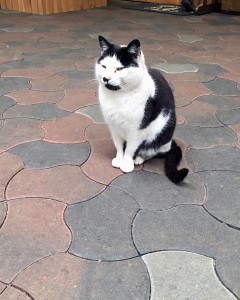Snorrastadir Farm offers horseback riding sessions for guests for an extra price, and most of the other students went. I decided to take the time for myself. It was very nice to have the place to myself for awhile except for our cook, Bjork.
I caught up on email and social media, then went into the hot tub. After half an hour I forced myself out, but then Emily and Yash arrived to tell us that they hadn’t started the horseback riding trip yet becaue the guide had an emergency with a sheep giving birth. So I got back into the hot tub for another half hour and was truly able to relax. By the time I got out, showered, dressed and packed, the ride was over and everyone was back. We ate some lunch and set out for the day.
The first stop was the Snæfellsnes town of Stykkishólmur. We climbed to the top of a lighthouse on the shore to get a 360 degree view of the town and the nearby islands. The lighthouse was on a tall island that had been artificially attached to the town by a blacktop parking lot. The view was quite impressive.
Here’s a view of Breiðafjörður, the fjord just north of Stykkishólmur, from the lighthouse:
After climbing down from the lighthouse island, I ran across a sculpture in the center of town. Tobba was there and told us it was a memorial to a ship that had gone down at sea which her grandfather had captained. His name, Sigvaldi Valentinusson, was listed at the top of the plaque.
After that we were free to explore town for an hour. I ended up at a small restaurant where I had a bowl of seafood stew with bread and hot tea at and called my husband, Paul. Everyone then met at the tourist center, where I bought a long scarlet and gray Icelandic scarf — the perfect warm scarf to replace the one I lost last year. It was pricey at $54, but it may turn out to be the best scarf I’ve ever had.
The next stop was the Bjarnarhöfn shark museum. To get there we passed through Berserkjahraun, a 3400-year-old lava field around which revolves another violent Icelandic story.
According to the Eyrbyggja Saga, two Norse warriors called beserks were brought to Iceland as slaves to farm. One beserk fell in love with farmer’s daughter, putting the farmer in an awkward position. The farmer consulted with a priest, who told him he could promise the daughter to the beserk if the slaves did an impossible task: digging a road across the lava field. The beserks did it in 30 days. So the farmer told the beserk he could have the daughter if he cleaned himself up. The farmer made a bath, added boiling water and cows’ skins, which weakened the beserks, then he clubbed them to death. They were buried in a depression in the road where the horizon can’t be seen. The remains of two large men were found in an archaeological site in the area, so there may be some truth to the story.
The Bjarnarhöfn shark museum was an interesting if somewhat disturbing stop. The museum processes 60 Greenland sharks per year, the second-largest shark species in world, native to waters off Greenland and Iceland. The sharks are not hunted specifically but caught as bycatch from large fishing trawlers. When we got there, one shark had just arrived. We got to touch it – the skin felt like sand paper.
The meat is toxic at first and must go through months of treatment to become edible. First they cut it into pieces and let it ferment for six weeks. Then they hang it up to dry for three to four months. Even then you can’t eat too much of the meat at once because it is so high in protein and vitamins. The museum had samples for people to try. I didn’t try it, but some in our group did. They did not care for it.
I liked the museum’s friendly black and white cat – who apparently doesn’t care for shark. And I was glad the museum didn’t hunt sharks for the purpose of attracting tourists. But it saddens me that the huge fishing trawlers we use in the oceans catch creatures as large as these sharks. A lot of our seafood supply is not fished sustainably, and we are overfishing the oceans so much fish stocks may crash before mid-century. Yet little of this is visible to ordinary people who live on land. It is a huge problem that needs much more attention than it is getting.
After the shark museum, we headed back to Agricultural University in Hvanneryi. Our first week of the trip concentrating on the area north of Reykjavik was complete, and tomorrow we would be packing up and heading to the southwest.




